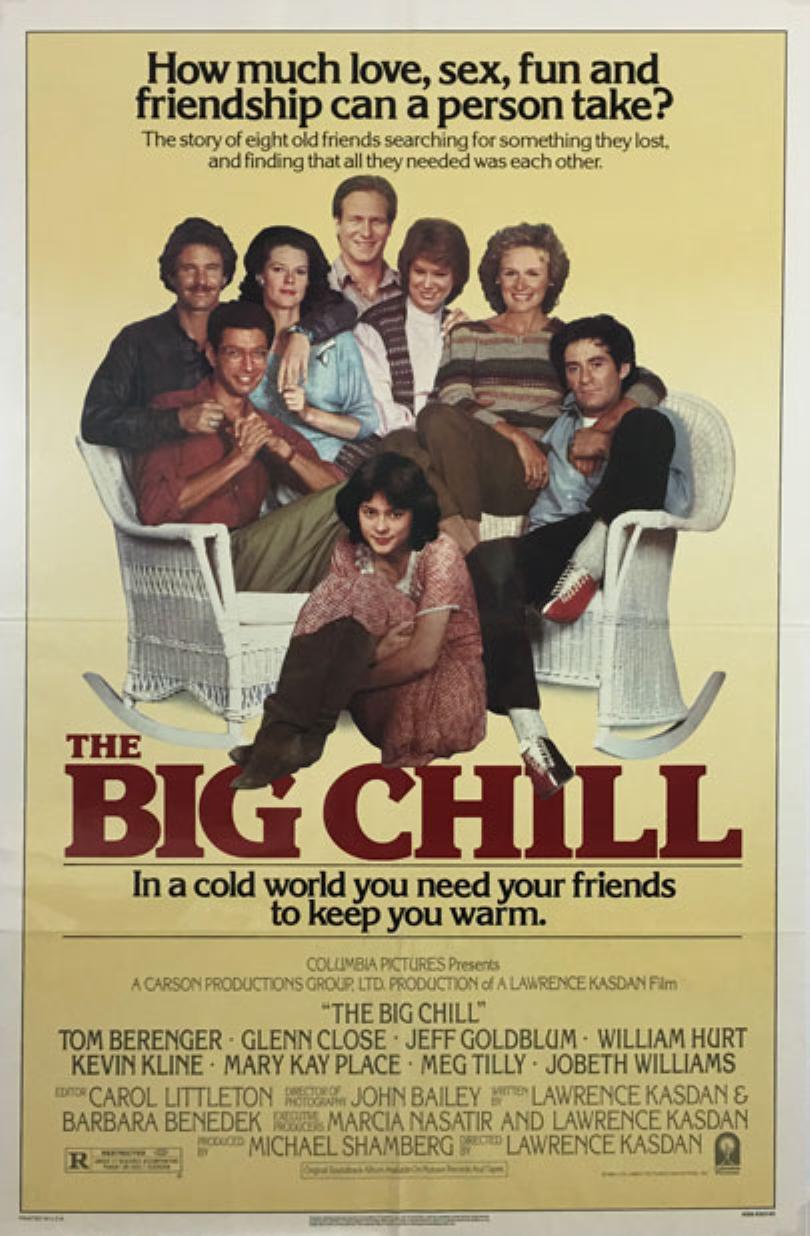 Let’s go back in time to September 1983… Kiss appeared for the first time without makeup… Vanessa Williams became the first African American to be crowned Miss America. In the weeks’ ahead, the first Hooters restaurant opened in Clearwater, Fla.
Let’s go back in time to September 1983… Kiss appeared for the first time without makeup… Vanessa Williams became the first African American to be crowned Miss America. In the weeks’ ahead, the first Hooters restaurant opened in Clearwater, Fla.
And on September 28, Columbia Pictures released a film whose name – decades later – still connotes a spirit of a generation of yuppies – the term had been coined just one year earlier – for thirty-somethings, dealing with the adjustments of adulthood, of life and death, of careers and friendships.
The film, of course, is The Big Chill. It starred an ensemble cast, most of whom were right in the “sweet spot” of their mid-30s. The plot centered around a group of University of Michigan classmates who reunite after 15 years, because of the sudden death of a fellow alum.
When the film opened in theaters, Kevin Kline and his on-screen wife, Glenn Close – who host the reunion – were 35 and 36, respectively. William Hurt was 33. Jeff Goldblum was only 30. Mary Kay Place had just turned 36. Tom Berenger, who played a TV star was 34. JoBeth Williams was also just 34. Meg Tilly, 23, played the dead classmate’s much younger girlfriend.
The film’s director and screenwriter, Lawrence Kasdan, was one of them; he was also 34 when the film was released. If you don’t recognize his name, you surely know his credits. Earlier that decade, he had written the screenplays for such blockbusters as The Empire Strikes Back and Raiders of the Lost Ark (and subsequently wrote The Bodyguard, Star Wars: The Force Awakens, and many more).
The movie’s advertising taglines seem quaint now. “How much love, sex, fun and friendship can a person take?” And playing on the film’s title, another read: “In a cold world you need your friends to keep you warm.”
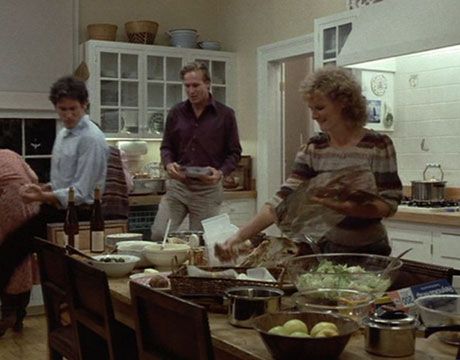
A screen grab from The Big Chill kitchen scene.
After their classmate’s burial, the group head to their hosts’ vacation home (with that great big kitchen) for the weekend, where a series of one-on-one conversations and plenty of group activities – sharing a joint, cooking – unspool for the film’s 105 minutes. Their characters include: a writer for People, an attorney, a Vietnam War vet, a housewife.
“It’s only out here in the world that it gets tough,” says Hurt’s character.
It’s clean-up time… Time to dance, in The Big Chill kitchen scene…
Despite the popularity of that kitchen scene and others that revealed the complexity of the classmates’ reunion, The Big Chill got a fairly mixed reception from the critics. The New York Times said it was a “very accomplished, serious comedy.” Time called it a “funny and ferociously smart movie.” Roger Ebert noted: “There’s no payoff and it doesn’t lead anywhere.” The Chicago Reader wrote: “There is no place for depth or nuance in this slickly engineered complacency machine.” Rotten Tomatoes has it at 69% positive.
Watch the trailer
Made on a minuscule $8 million budget, The Big Chill received a warm embrace at the box-office. While its $56 million take may not seem big, it was large enough to be 1983’s #13 largest. To put things in perspective, only two titles that year earned over $100 million.
And then there was the music. The original soundtrack, released by Motown, featured classics from the Temptations (“My Girl,” “Ain’t Too Proud to Beg”), Aretha Franklin (“[You Make Me Feel Like] A Natural Woman”) and Smokey Robinson and the Miracles (“I Second That Emotion,” “The Tracks of My Tears”). In the film, but not cleared for inclusion on the album, was the Rolling Stones’ “You Can’t Always Get What You Want.”
[Though the album peaked on the sales chart at just #17, it was a big success and continued to sell as a catalog item: it’s been certified 6x Platinum.]
And, of course, there was Marvin Gaye’s “I Heard it Through the Grapevine.”
When we hear the song in the opening credits, there’s a tear rolling down Close’s cheek. In between shots of the other classmates, we see a man getting dressed in a pinstriped suit. It’s only when we see the final shot of the man – we’ve never seen his face – we discover that he’s being dressed at a funeral parlor.
Watch the opening scene
The actor who played the deceased classmate had all of his scenes cut and thus never appeared in the film. His name? Kevin Costner.
The Big Chill was nominated for three Academy Awards: Best Picture, Best Actress in a Supporting Role (Close) and Best Writing, Screenplay Written Directly for the Screen (Kasdan). The film and soundtrack are available in the U.S. here, in Canada here and in the U.K. here.
Related: Another film favorite, also starring William Hurt
- Radio Hits of January 1965: British Invasion - 01/03/2026
- Peter Gabriel Surprises With 2026 Album, o\i - 01/03/2026
- When Mets Fans Serenaded Billy Joel With ‘Piano Man,’ He Sang, Too - 01/02/2026

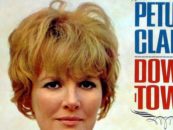
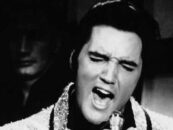
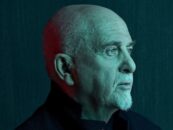


10 Comments so far
Jump into a conversationForget this slick piece of junk and get John Sayles “Return of the Secaucus Seven” instead. It doesn’t have the musical soundtrack this one does but it’s truer.
I second that emotion! 🙂
I saw and loved both films. But Secaucus involved the small cohort of college lefty activists. The Big Chill involved the much larger segment of those who slipped right into adulthood and pre-mature middle age. If you liked Secaucus, track down Alain Tanner’s “To Jonah Who Will Be 25 in the Year 2000.”
I wasn’t yet 20 when this movie came out. These people seemed so old! If I’d watched it again 15 years later perhaps it would have resonated with me a little more.
Honestly all I remember is the soundtrack.
The soundtrack made up for some of the slow motion conversations. Although it was taking a poke at their own life style, the music was clearly the winner.
What about all the other great classic music, besides Aretha. You can’t forget about the infamous Spencer Davis and Creedence. They helped Pull the timeline together.
Still all great actors even on their own.
Still one of my favorite movies and you can’t beat the soundtrack
Timeless. A truly great film about a time when we weren’t full of ourselves. Where friendship and personal bonds were real. Not manufactured over junk like social media. We live in very sad times. Give me the 80’s over this era everyday all day.
It’s difficult to be objective about whether the film still stands up if you were of a relevant age when it came out, and it had personal significance for you then. But with all the great actors in it, and a terrific director at the helm, I still enjoy it every once in a great while. The only criticism I have of the film now is one that helped make the film the success that it was — the soundtrack. While these mostly Motown songs certainly aided in creating the essential vibe that made this film work in its day, I find now that almost all of them (perhaps Aretha aside) have been over-played so much over the years that I have no desire to hear them anymore. So, for me, the very thing that served as the good-time grease during the film’s original release, now makes it appear dated, and somewhat obvious in its attempts to manipulate its audiences. I guess equally great but more obscure songs would have given the film another level of the cool factor, but it probably wouldn’t have reached the mass audience that it did without the songs they chose. My only exception to the criticism is the film’s use of “Gimme Some Lovin.” You can’t ever go wrong with that song, and I never tire of hearing what I believe may be the greatest rock song of all time.
I was 30 when this movie came out and I could totally relate to everything they were doing and talking about. I thought the cast was perfectly paired. And the music … some of Motown’s best. I have it on VCR tape and saved on my DVR. I still enjoy watching it.
Was 21 at the time of the release, all of the high school gang about 10 of us saw this together. We walked out of there in silence knowing we saw something that seemed so far away yet close at the same time. We had a hard time grappling with how college impacted our lives then to add death into the mix was hard for many of us.